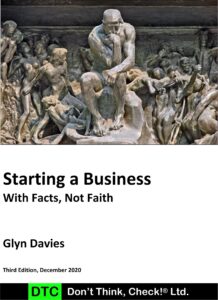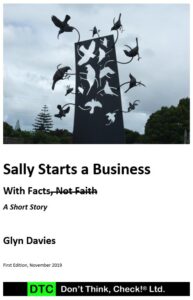
Introduction
Are there only six rules for creating a better business? No, not really, there are probably about a billiontyone, but let’s start with six for now …
There are several pervasive and persistent assumptions (myths) in business; two of them are:
- A business needs to offer a Unique Value Proposition (UVP) to attract customers.
- Years of competition have turned products and services into commodities.
While there is an element of validity to those assumptions, they mostly miss the vital nuances.
This paper is based on Six Rules to Become Simply Better, by Patrick Barwise and Sean Meehan (Barwise & Meehan, 2004).
In their paper, Barwise and Meehan argue that what customers care about is that businesses provide the generic category benefits that matter to customers and that businesses deliver those benefits better than any other business can.
Also, (Sharp, 2014) discusses that obsessively trying to differentiate your solutions by creating a UVP is a never-ending and perhaps futile task, as there is little that cannot eventually be copied by your rivals. Instead, Sharp argues, whereas your solutions certainly need to be competitive, what’s more important is that your solutions are distinctive.
The root of the matter is that there is little need to get sophisticated, especially when so many businesses haven’t yet explored and exploited the limits of the basics. And at its most basic, what a business needs to do is identify the core of the business, where the majority of the cash is coming from; find the core and then sell as many as you can.
The Rules
Rule 1: Think category benefits, not unique brand benefits.
There is a temptation for a business to improve every aspect of their solution (product, service, and experience bundle) to ensure that it stands out, or at least matches or exceed the category benchmarks. But such approaches, being internally focused, are potentially short-sighted.
Sure, a business needs to be operationally efficient to remain in the game, but what is often lacking is the customers’ perspective. Are there missed opportunities delivering with great efficiency solutions that don’t satisfy all the customers’ needs?[1]
A business needs to look externally to category customer needs that have been identified but inadequately met, the needs that have been identified and not met, as well as those needs that have not yet been identified.
There can be an element of complacency in the market where businesses have inadvertently trained themselves and customers to accept the status quo of solution offerings. With few convenient alternatives, customers may have even resigned themselves to this perspective. But is it really the case that your current solution is as good as it gets? Have you confirmed this both from the solution-provision perspective and from the customer-needs perspective? Have all the customer and non-customer category needs been articulated? Have you addressed them all?
What do customers like and dislike about the category, not just your branded solution?
Rule 2: Think simplicity, not sophistication.
Businesses can perform sophisticated segmentation analysis and identify different types of customers. Some segments are even given names, such as, for Harley-Davidson motorcycle riders, Dream Riders and Hard Core (see post Does Customer Loyalty Exist?).
But ultimately, customers simply want their needs satisfied expediently; they don’t care what you call them. Customers are notorious for being “polygamously loyal” (Sharp, 2014), some may even say fickle. Simply put, customers have needs, they want those needs fulfilled, they want to pay for their chosen solution quickly, and they want to get on with their lives. And what’s more, they reserve the right to change their needs or their preferred solutions without consulting you or fearing that they will not fit the segment-definitions that you have concocted.
Get the solution functional basics right. People stopping at a fuel station are principally there to refuel and pay easily and quickly while sheltered from the weather, and then they want to get on with their day. Refuelling their vehicle is a necessary encumbrance; it is not the goal. Fuel stations are not often known for their great coffees, and would not typically become a destination for such. Having clean toilets however, is important to customers; why would any business not have clean toilets?
Excel at the basics, then if it’s appropriate, you can add nice-to-have benefits, as ‘cream on the basics.’
Rule 3: Think inside, not outside, the box.
It seems fashionable to seek novelty in business, to ‘think outside the box (that is your business)’ by investigating acquisitions, partnering, and outsourcing of core activities all the while without fully appreciating the balance of all the risks that accompany the benefits. A case in point is the dependence on global supply chains that break during a pandemic.
Another of the risks is that novel activities, outside the box, divert our attention from what is inside the box, that is, getting the basics right. The basics such as completely understanding customers with their ever-changing needs, understanding rivals and the threats that they present, and ensuring the most cost-effective development, delivery, maintenance, and continuous innovation of solutions.
Sort the inside of the box out first. Only once you have exploited the full potential of what’s inside the box should you contemplate possibilities outside of the box.
Rule 4: Think opportunities, not threats.
It is all too easy for a business to feel secure when it finally achieves elusive success; many don’t. While celebrating one’s wins is recommended, it is not wise to become complacent. There are always changes in the market. Category expectations evolve, category demographics age, technology changes, tastes and fashions change, and the competition is hardly going to let you keep that big slice of the pie all to yourself without a challenge.
In much the same manner as for a Minimum Viable Solution (MVS), a business should always be looking for ways to provide category benefits worth paying for. A business needs to be mindful of its costs as well as watchful of competition, but not at the expense of innovation, even if that means cannibalising its own solutions. It’s better that a business cannibalises its own solutions than it is for its solutions to be obsoleted by the competition.
Regardless of the cause for change, say government regulations, technology shifts, or the ever-changing needs and desires of customers, a business should look at the needed innovation not as threats, but as opportunities to retain the privilege to continue to serve its category customers and prospective customers.
Also see this post, Enduring Transient Competitive Advantage.
Rule 5: For creative advertising, forget Rule 3.
The post Developing a Business Strategy: Profit From Prophets? discusses the need for your brand to be distinctive in the category-swamp of also-rans.
To achieve distinction means that you will need out-of-the-box thinking to ensure that your solution(s) and indeed your brand are noticed and remembered. Your brand needs to be the tall poppy, it needs to be noticed. Once noticed, your brand’s value can then be appreciated. But first it needs to be noticed, and it then needs to be available through your Marketing Strategy. Your Marketing Strategy will make your branded solution(s), or more simply your brand(s), available to prospective customers, where availability refers to both:
- Mental availability – the number of associations a buyer has about the brand, the strength of those associations, and the relevance of the associations to the buying context.
- Physical availability – making the brand as easy to find and buy as possible. (Sharp, 2014).
Don’t be shy, be the poppy!
Rule 6: Think immersion, not submersion.
Simple economics and efficiency drive owners and managers to specialise, to submerge themselves, in their business, but specialisation risks that decision-makers can become far removed from customers and their needs. Don’t rely on subordinates to provide market and category insights; get out of the office and see for yourself. Aside from their potential lack of interest, skill, and available time, there is a real risk that subordinates will filter and massage information into what they think ‘the boss’ wants to hear.
The metaphoric phrase “shooting or killing the messenger” has a long history and for good cause. There is a real risk for messengers in bringing bad or unpopular news or views, ranging from provoking the displeasure and wrath of the recipient to being blamed for not being a ‘team player’ for not seeing reality according to the authorised dogma.
Many businesses require new staff, even senior managers, to spend time ‘in the field’ with customers to learn what it is like to be them, to ‘walk a kilometre in their shoes,’ to hear ‘the voice of the customer’ (VOC). Some businesses have annual and some even have monthly frontline secondments as refreshers and to keep managers grounded in what is important to customers.
Immersion in the customers’ experience brings valuable insights. To paraphrase Steve Blank, “there are no customer insights (facts) in your building, so go (outside) to where your customers are,” immerse yourself in and witness the customer experience. Learn of their current and emerging needs. However, gathering insights is not enough; do something with them.
Finally
Attaining and then maintaining a competitive advantage is elusive. As discussed in Enduring Transient Competitive Advantage, remaining competitive is a never-ending quest. Success in this quest can only come from a deep understanding of your customers, and consistently delivering what currently matters most to them.
Related Material
There is no invariant and definitive list of what to do to achieve success in business. There are too many variables. What is achievable is to create easily understandable and actionable ‘nuggets’ of information that may be applicable to some businesses some of the time.
The following post is such an example: What Really Works – the 4+2 formula for sustained business success.
Bibliography
Barwise, P., & Meehan, S. (2004, Autumn). Six Rules To Become Simply Better. Business Strategy Review, 25-31.
Sharp, B. (2014). How Brands Grow: What Marketers Don’t Know. Oxford University Press.
[1] Paraphrasing Peter Drucker, “There is nothing quite so useless, as doing with great efficiency, something that should not be done at all.”



